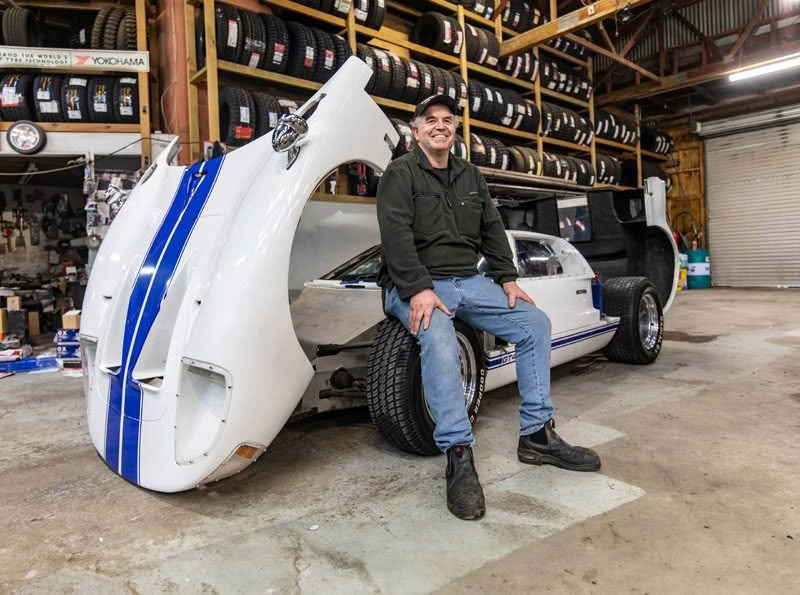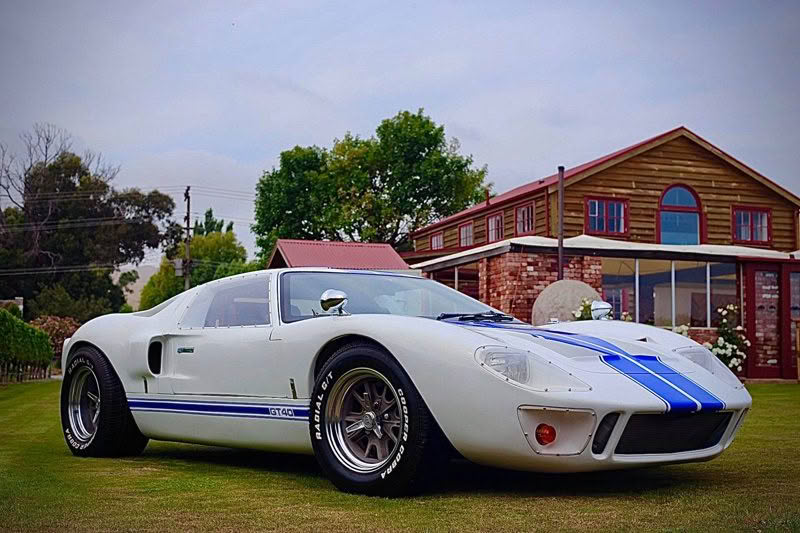Tinkering with tools & tyres

A lifelong passion for V8s led to Julian Cameron fulfilling his dream pastime of building his treasured Ford 1966 MKII GT40.
Words Jane Warwick
When Julian Cameron asked his grandson if he wanted to come with him to The Roadhouse Breakfast in Blenheim (a get-together of auto enthusiasts), the three-year-old was metaphorically in his grandad’s car before the question was finished. On the day, Israel’s enthusiasm hadn’t waned, but Julian shouldn’t have really been surprised. Julian was the same age when he was helping his uncle tinker with vehicles and doing skids in his pedal car. He was only a couple of years older when he was actually doing some mechanical chores himself under his uncle’s guidance. In fact, by the time he was 12 or 13, Julian had saved up the $250 needed for a proper mechanic’s toolbox of his own, not small change in those days.
When he visited his grandma and uncle in Timaru, Julian would peruse his uncle’s collection of car books, particularly those on the racecars his uncle was obsessed with, an obsession he passed onto his wee nephew who developed a lifelong passion for such cars.
But, oddly enough, Julian didn’t leave school and become an apprentice mechanic, not least because such apprenticeships weren’t that easy to find. He worked instead on his friend’s parents’ farm, in his spare time tinkering away at Automove, a workshop they also owned. By this time, he and his family were living in the coastal town of Picton, so it wasn’t surprising that it was the fishing industry Julian came off the farm to work in, with the bonus that the pay was astoundingly good – $250 in the hand for half a day’s work; $1,500 for not too many hours more. He got his skipper’s ticket, worked hard and diverted into mussel farming – still finding time to potter around workshops – and by the time he was 36 he had married Michelle and paid off their house.
All this was leading him inexorably to his dream job, or at least the chance to pursue his dream pastime.
Julian saw a gap that needed filling – tools and tyres. He opened his own shop, with money from his lucrative mussel job to fund it, and although he originally thought it was going to be a fill-in job when he wasn’t out in the Marlborough Sounds attending to mussel farms – the sort of job where he would have flexibility to do such domestic things as school runs – business was soon booming.
He came ashore full-time and opened Picton Tools & Tyres and at long last got the space he wanted to indulge himself in cars. He has a passion for V8s, and one such vehicle in particular. In those long-ago days of flipping through his uncle’s car books, there was a marque that especially stood out – Ford’s GT40 developed to take on Ferrari at Le Mans. And in 1966 Kiwis Bruce McLaren and Chris Amon did just that in the model, helping Ford thumb its nose at its Italian competitor.
It was this car, the Ford 1966 MKII GT40, that the young Julian had spotted in his uncle’s book, an image that he held onto all these years. An authentic model was way out of his reach. Only 30 were ever built and an original had reportedly sold for USD 26 million, but there were replicas around. He kept searching the car sites and then, almost 10 years ago, one popped up in Christchurch, conveniently at a time when Michelle was in Australia visiting her father-in-law and not keeping an eye on her husband. Julian snuck off and bought it, feeling pretty clever, only to find out his dad had mischievously dobbed him in. Luckily, Michelle didn’t mind.
‘I had always wanted a GT40. What’s not fascinating about this vehicle? They were designed to take on Ferrari at Le Mans and they won; they have this incredible shape; in 1966 they were achieving 215 mph! They’re just incredible.
‘The body and chassis were a little in bits; there were no brakes, nor cooling system. It was pretty much in the condition I had expected although maybe the fibreglass body was a bit more battered.’

Nevertheless, the vehicle looked pretty good sitting in Julian’s workshop. He tinkered with it in his spare time for eight years, searching and tracking down parts and constructing. Not all Ford parts could be found; for instance, the air vent is from a Zephyr, and he believes the taillights to be Fiat, but they are all of the era. He fashioned the back window himself from Lexan polycarbonate plastic and found suitable side windows, although they didn’t have the little pivoting quarter vent window.
Later, however, he found exactly the windows he wanted when visiting his father, from Queensland-based DRB Sportscars, which specialises in replica vehicles. He enjoyed the tinkering, admitting there were a lot of two steps back to take one step forward, but the project was coming along nicely.
Then, within six weeks of her wedding in 2020, daughter Chloe decided it simply had to be her wedding car – she and her sister Samantha are as enamoured with such classics as their father – so Julian had just over a month to cut and fibreglass for the occasion. Chloe had absolute faith that her father would achieve this and helped out when she could. He worked every spare moment … did all the painting himself and hand-cut all the vinyl stripes with a razor blade, but got the GT40 logo done by a friend with a proper cutter.
On the wedding day it was flawless. All those years of tinkering and searching for parts, all those days when he simply didn’t have the time to even admire it, let alone work on it, no longer mattered. He had produced the perfect car, for the perfect day.

